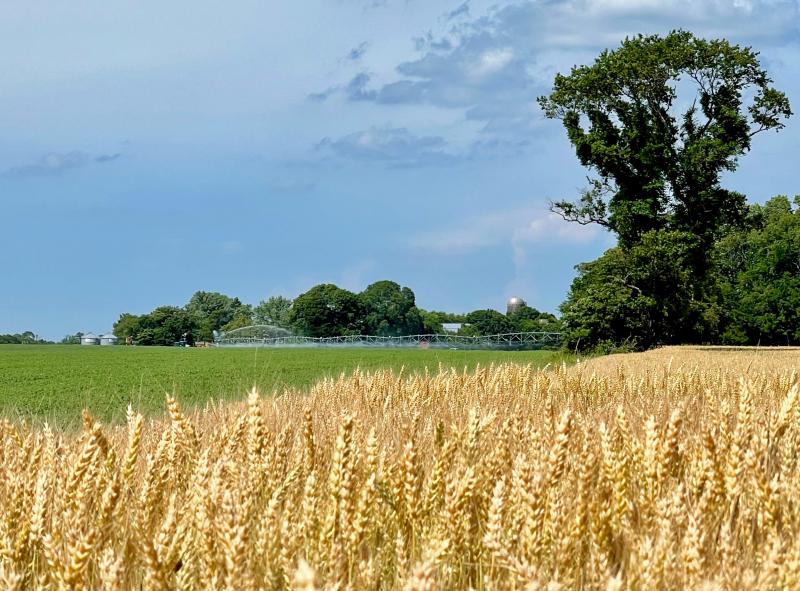Tourist season is also planting, harvesting season
While resort business people are settling into the 2021 tourist season, Sussex County farmers are planting and cultivating corn and soybean crops, and getting ready to harvest this year’s wheat crop.
According to information provided by Delaware’s Department of Agriculture, the state’s farmers plan to increase their acreage of soybeans this year while reducing their corn acreage. Nothing unusual there. They seem to bounce back and forth between the two, rotating soybeans now and then to get the benefit of the nitrogen-fixing bacteria in the soybean roots. Corn depletes the soil of its natural nitrogen, requiring the addition of fertilizer with nitrogen to meet the plant’s requirements. Soybeans, on the other hand, convert nitrogen in the air to a usable form and help supplement the soil in the process.
Corn continues to be the state’s largest single crop in terms of acres planted. Soybeans come in a close second and wheat comes in third. Every bit of the state’s corn and soybean crops goes straight to feeding chickens, the state’s largest agricultural category by far.
According to estimated plantings for 2021, farmers are expected to cultivate 170,000 acres of corn this year compared to 180,000 in 2020, 165,000 acres of soybeans this year compared to 150,000 last year; and 60,000 acres of wheat this year compared to 75,000 last year. More than 20,000 acres of wheat are grown in Sussex County, usually followed by late soybeans.
How does it all translate into dollars for the local economy? According to statistics gathered by the ag department for 2020, Delaware farmers harvested 28,160,000 bushels of corn worth $121,088,000 at an average price of $4.30 per bushel. The average corn yield in 2020 was 160 bushels per acre, much more on irrigated land, less on unirrigated.
The soybean harvest, with an average price of $8.75 per bushel, brought $63,455,000 to the Delaware economy with 7,252,000 bushels harvested. The average soybean yield was 49 bushels per acre.
For wheat, the 4,015,000 bushels harvested, at $5.55 per bushel, brought $22,283,000 to the economy.
As of this week, corn is selling at $6.83 per bushel and wheat is bringing $6.87. It’s hard to tell what the prices will be at harvest time in the fall, but forecasters are expecting prices to remain high with worldwide demand and population growing, and the global pandemic beginning to ease.
Delaware Department of Agriculture spokesperson Stacey Hofmann said crop damage from Delaware’s population of white-tail deer continues to be a problem for farmers.
Regarding Harbor of Refuge
As a follow-up to last week’s column about deterioration of the east end of Harbor of Refuge breakwater and the danger posed to the lighthouse there, U.S. Army Corps of Engineers spokesman Ed Voigt sent along a status report from 2020.
He noted that due to pandemic limitations, little work has been done regarding the concerns.
Here's a paragraph from that most recent report which further confirms the seriousness of the matter.
“It has been brought to USACE attention by both the Delaware River and Bay Lighthouse Foundation and the Delaware State Historical Preservation Office that the deterioration of the government-owned breakwater is impacting valuable historic properties in the Harbor of Refuge.
“A recent inspection of this site confirms these concerns. The destructive wave action from Hurricane Jose [September 2017] has had an erosive effect on the breakwater especially in the vicinity of the lighthouse. Many of the huge breakwater stones that once formed an interlocking protection wall at the base of the lighthouse have been dislodged.
“In the interest of protecting the historic integrity of the National Harbor of Refuge Breakwater itself along with ensuring the protection of the historic lighthouse, the initiative to periodically inspect the wall, especially after hurricane season, is a most crucial issue that is time sensitive. FY2020 capability exists to continue this work.”
No word yet as to whether that FY2020 capability will be translated into action to save the iconic lighthouse.


















































